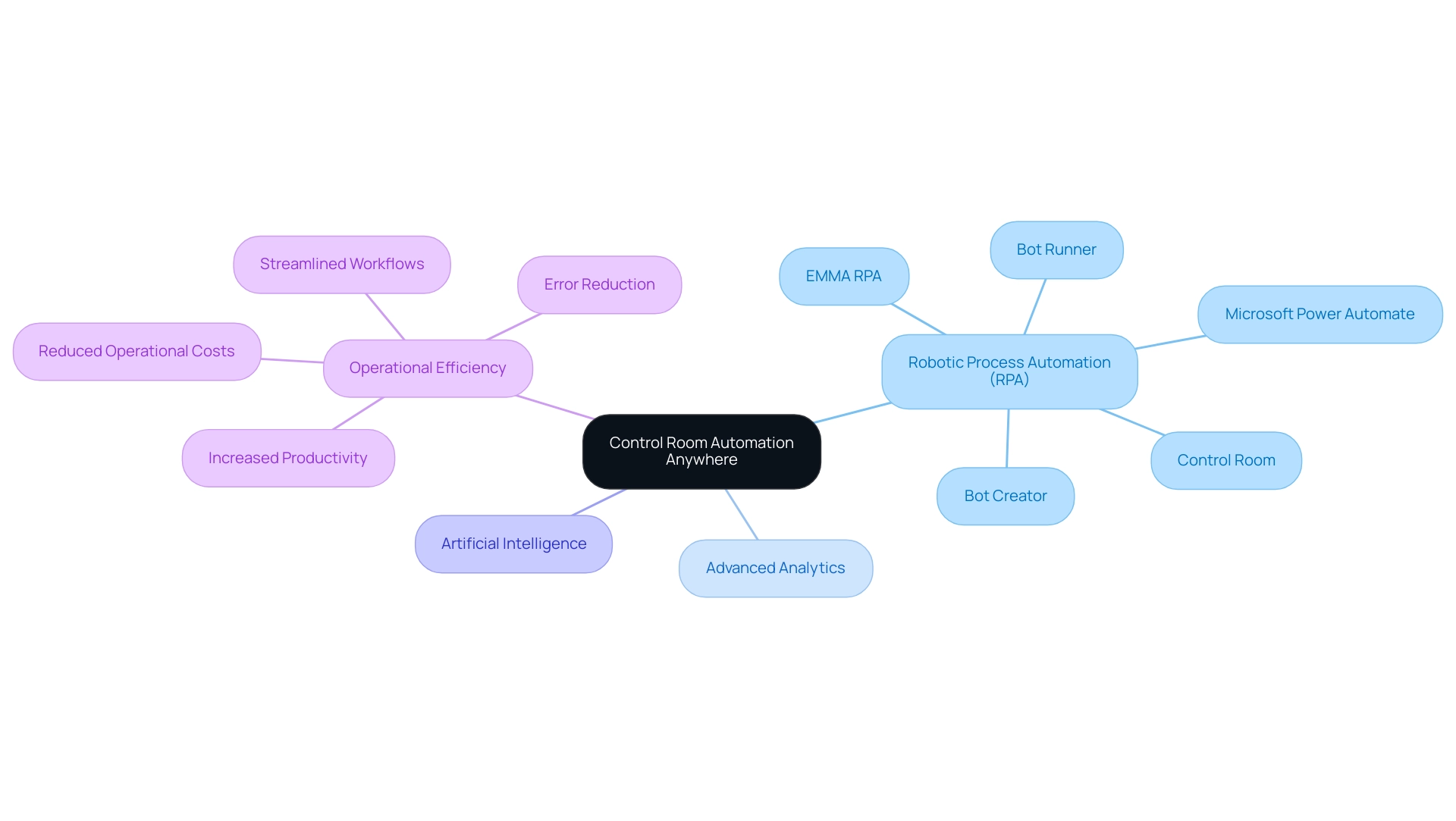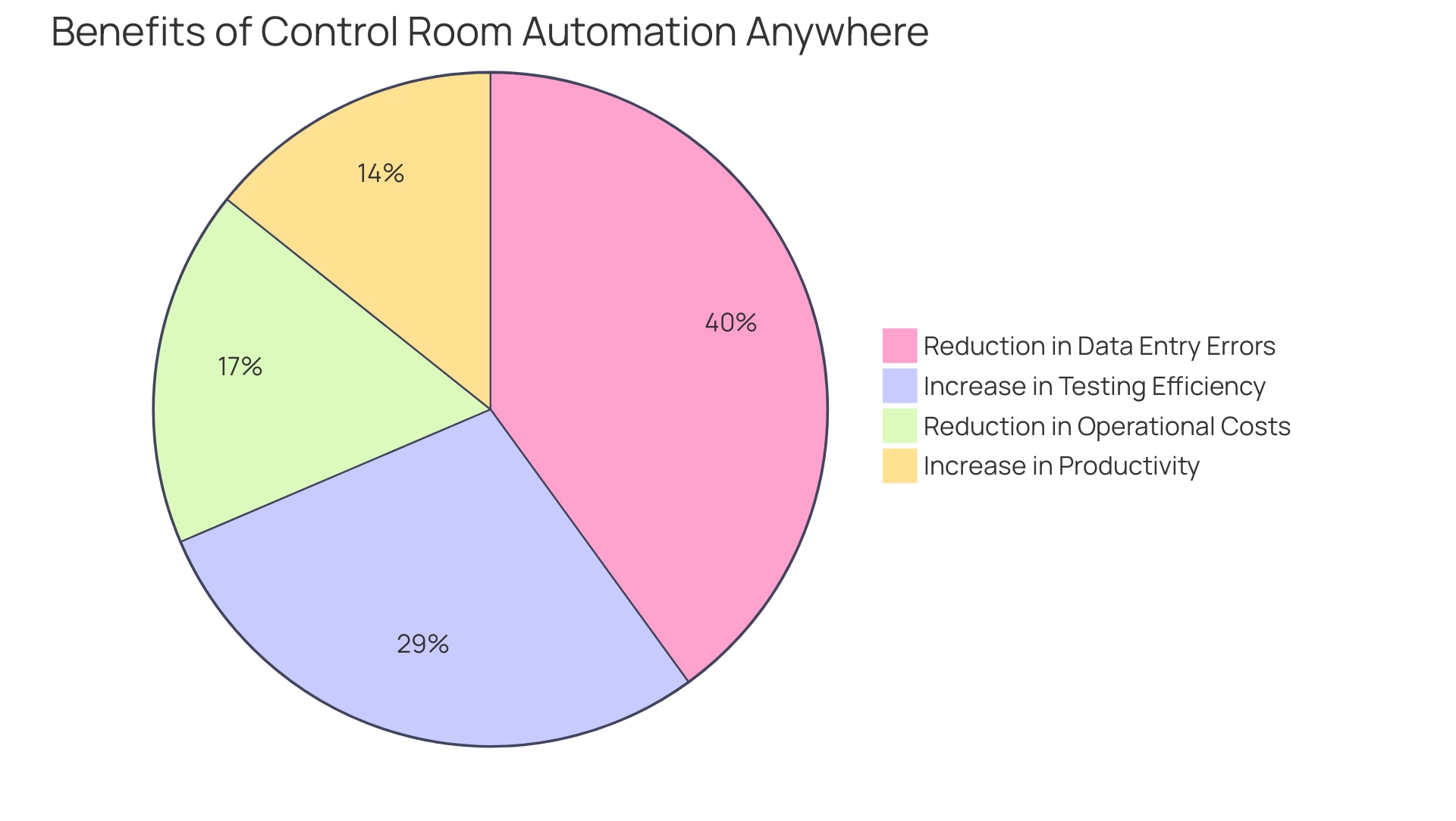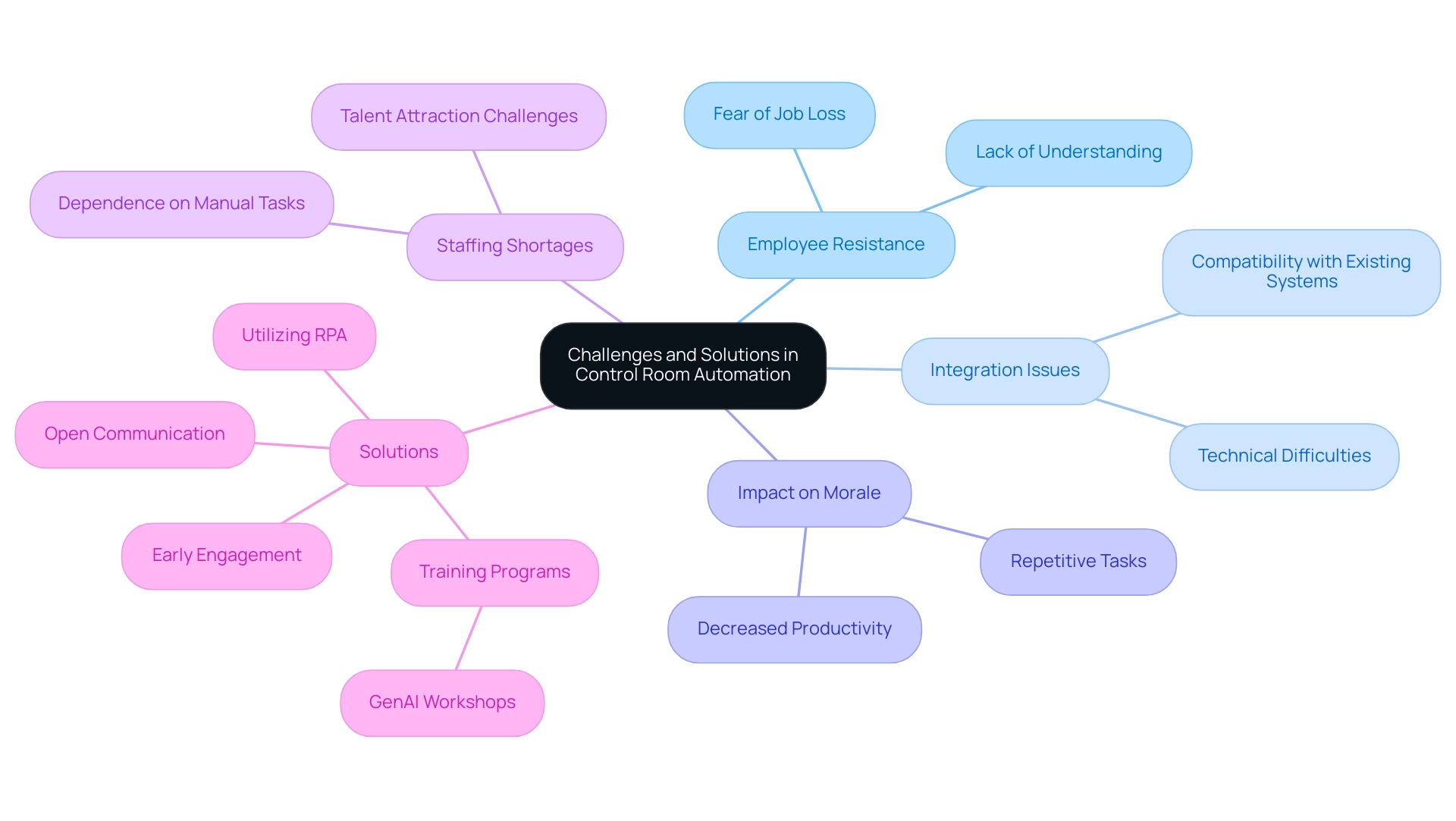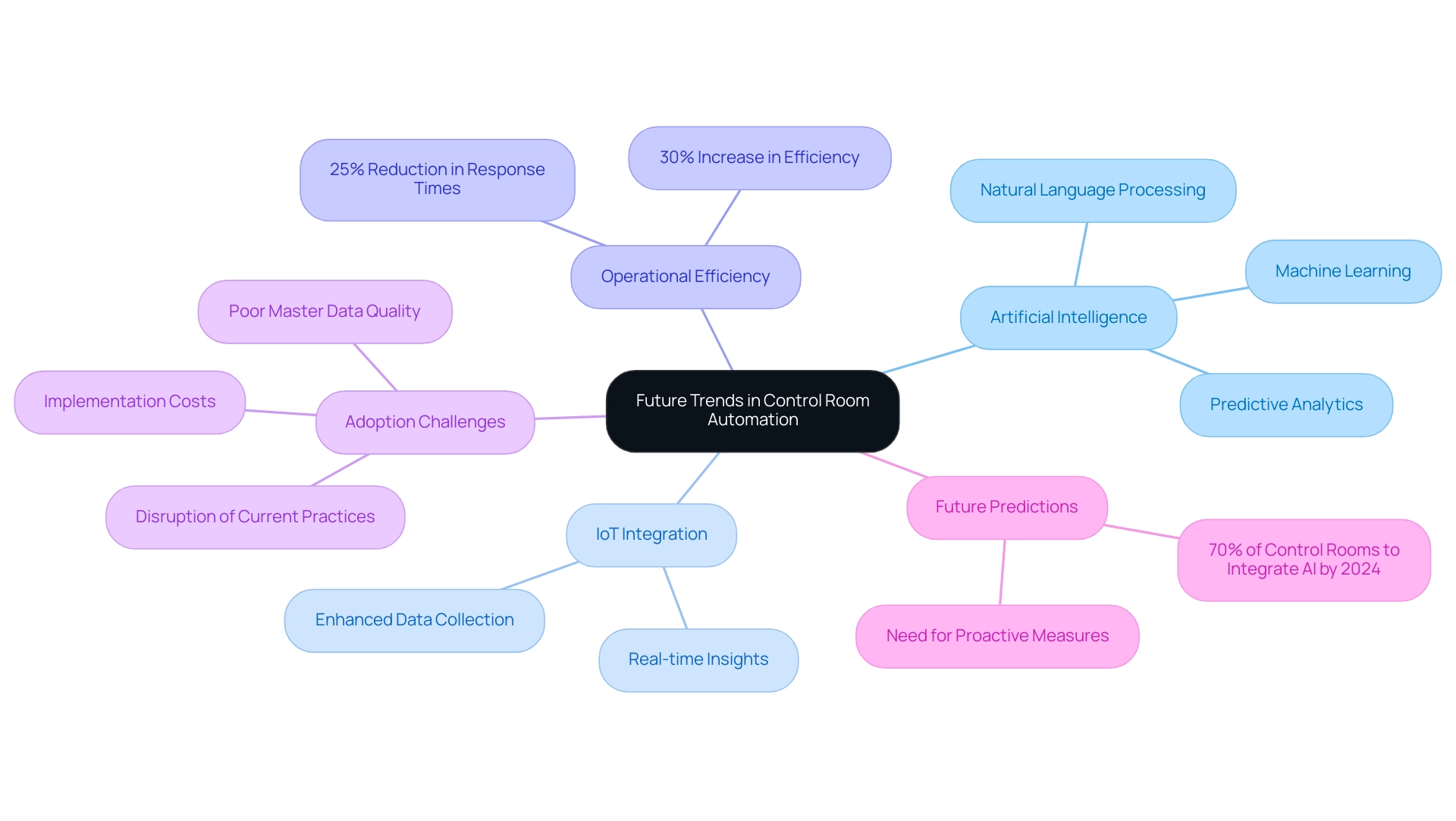Introduction
In the dynamic landscape of modern business, the integration of Control Room Automation Anywhere is transforming operational efficiency. This innovative platform harnesses the power of robotic process automation (RPA), artificial intelligence, and advanced analytics to streamline workflows, reduce manual errors, and empower organizations to focus on strategic objectives. As industries increasingly adopt these technologies, they are witnessing remarkable improvements in productivity and cost-effectiveness.
However, the journey toward successful implementation is not without its challenges, including employee resistance and integration hurdles. By addressing these issues head-on and embracing a culture of collaboration and training, organizations can unlock the full potential of automation, paving the way for a future where efficiency and innovation go hand in hand. As 2024 approaches, the imperative to adapt and leverage these advancements becomes clearer, positioning businesses to thrive in an ever-evolving environment.
Understanding Control Room Automation Anywhere
Control Room Technology Anywhere signifies a state-of-the-art solution designed to improve operations within control room settings. This strong platform effortlessly combines robotic process technology with advanced analytics and artificial intelligence, enabling entities to optimize their processes, improve decision-making, and enhance overall operational efficiency. With the ability to automate routine tasks, including those managed by innovative tools like EMMA RPA and Microsoft Power Automate, Control Room from Anywhere significantly reduces manual errors and accelerates workflow, ensuring that critical operations are executed flawlessly.
As a centralized hub, it provides organizations with the tools to monitor, control, and optimize their automated workflows effectively. The outcome is a remarkable increase in productivity alongside a reduction in operational costs, enabling teams to focus on strategic initiatives rather than mundane, repetitive tasks. The increasing acceptance of control room technology is reflected in a projected rise of 25% in efficiency metrics by 2024, with numerous facilities now exploring creative financing options to acquire these advanced robotic systems, making them accessible even to smaller healthcare facilities.
Real-world implementations of RPA in control rooms have shown significant improvements. For instance, a prominent healthcare provider employed Anywhere to streamline patient scheduling and billing procedures, leading to a 40% reduction in processing time and a 30% decrease in errors. Notably, experts like T. Sloane Guy, MD, MBA, emphasize the operational impact of such technologies, stating, ‘As we increase our volume, the number of robots increases with it.’ This sentiment corresponds with key case studies illustrating how platforms like Automation Anywhere, which incorporates elements such as Bot Creator for designing workflows, Control Room for managing RPA robots, and Bot Runner for executing tasks, have successfully transformed operational landscapes.
Additionally, EMMA RPA enhances operational efficiency through features like seamless digitalization and user-friendly interfaces, making it accessible for diverse applications. Power Automate streamlines workflows by connecting apps and data, offering AI-driven processes that are both accessible and efficient. As we anticipate 2024, the continuous improvements in robotic task management, along with the risk-free ROI evaluation method that enables companies to assess their investments in mechanization without initial expenses, are set to transform how control rooms function, enhancing their efficiency and effectiveness in addressing the needs of contemporary business.

Benefits and Applications of Control Room Automation Anywhere
The benefits of Control Room Automation Anywhere are vast and significant, especially in improving operational efficiency through systemization. By automating routine tasks such as data entry, report generation, and task monitoring, teams can redirect their efforts toward more strategic initiatives.
For example, a mid-sized healthcare firm that adopted GUI mechanization encountered difficulties such as manual data entry mistakes and sluggish software testing, but experienced a 70% decrease in data entry errors and a 50% increase in testing efficiency, greatly improving patient care.
Additionally, companies that adopted automation in their control rooms experienced a 30% reduction in operational costs and a 25% increase in productivity. Mechanization not only boosts efficiency but also enhances accuracy and minimizes errors, as automated processes are inherently less susceptible to human oversight.
A crucial aspect of Control Room Anywhere is its ability for real-time monitoring and analytics, offering entities with actionable insights that enable informed decision-making. These examples highlight the technology’s versatility and effectiveness, making it a compelling option for entities aiming to enhance their operational capabilities.

Challenges and Considerations in Implementing Control Room Automation Anywhere
Implementing Control Room Automation Anywhere can yield significant advantages; however, companies often encounter various challenges in the process. A crucial obstacle is employee opposition to change, with studies suggesting that up to 70% of employees may resist new technological advancements due to a lack of understanding about their benefits. This resistance is often compounded by integration issues with existing systems, making a thoughtful approach essential for ensuring compatibility.
For instance, case studies show that organizations like Company X encountered significant resistance from employees when implementing automated processes, resulting in delays and higher expenses. Furthermore, repetitive tasks can significantly impact employee morale and productivity, exacerbating resistance to change.
To combat these issues, fostering a culture of open communication and collaboration is vital. This environment enables employees to express their concerns and gain insights into the transformative potential of technology. Expert opinions indicate that engaging employees early in the automation initiative can significantly lessen resistance.
Moreover, investing in comprehensive training programs, such as our GenAI workshops, equips teams with the necessary skills to effectively implement and manage AI solutions, enhancing acceptance and productivity. Furthermore, entities are increasingly encountering staffing shortages, making it essential to utilize RPA solutions to lessen dependence on manual tasks and draw talent by providing more engaging work.
By proactively tackling these challenges and utilizing RPA solutions to combat repetitive tasks and staffing shortages, companies can not only implement Control Room Management Anywhere effectively but also unlock its full potential to streamline operations, drive efficiency, and ensure sustainable growth.
Significantly, our risk-free automation services concentrate on providing measurable ROI, guaranteeing entities that they only pay if the process is automated as intended.

Future Trends in Control Room Automation Anywhere
The future of Control Room Automation Anywhere is set to experience remarkable advancements, driven by the rapid evolution of artificial intelligence. Enhanced capabilities in predictive analytics, machine learning, and natural language processing will significantly improve entities’ ability to automate complex tasks and make informed, data-driven decisions with precision.
For instance, a recent study found that entities implementing AI in control room operations have seen a 30% increase in operational efficiency. Furthermore, the integration of Internet of Things (IoT) devices is poised to revolutionize data collection and monitoring, facilitating real-time insights that enhance operational efficiency.
However, many entities remain hesitant to adopt AI due to concerns over poor master data quality and the perceived complexities and costs associated with implementation. As observed by industry expert Humphreys, the impact of these technologies frequently interrupts current production and management practices, highlighting the urgency for entities to adapt.
To alleviate these concerns, custom Small Language Models (SLMs) offer powerful, cost-effective capabilities tailored to specific industry needs, ensuring enhanced privacy and efficient data analysis. SLMs can help improve master data quality by streamlining data processing and providing accurate insights, which mitigates the fear of integration challenges.
Additionally, a case study on a leading energy company demonstrated that the adoption of AI-driven control room automation led to a 25% reduction in response times to operational incidents. Embracing these innovations, including leveraging Robotic Process Automation (RPA) to automate manual workflows, is not just advantageous; it is essential for organizations seeking to thrive in an increasingly competitive landscape.
RPA can significantly decrease the time and expenses linked to manual tasks, addressing the common perception that AI initiatives are time-intensive and expensive. Those that remain agile and proactive in adopting these cutting-edge technologies will be well-positioned to lead the way in the future of control room operations, especially as we look toward the trends shaping 2024 and beyond.
Expert predictions suggest that by 2024, AI will play a critical role in enhancing decision-making processes, with 70% of control rooms expected to integrate advanced AI solutions, highlighting the urgency of overcoming these implementation challenges.

Conclusion
The integration of Control Room Automation Anywhere offers a transformative approach to enhancing operational efficiency, enabling organizations to streamline workflows and reduce manual errors through advanced technologies such as robotic process automation and artificial intelligence. By automating routine tasks, teams can focus on strategic initiatives that drive growth and innovation. Real-world applications have demonstrated significant benefits, including reduced processing times and operational costs, underscoring the effectiveness of this automation solution.
However, the path to successful implementation is not without its challenges. Employee resistance and integration hurdles are common obstacles that can hinder progress. By fostering a culture of collaboration, investing in comprehensive training, and involving employees early in the automation process, organizations can address these challenges head-on.
Emphasizing open communication and showcasing the tangible benefits of automation can help to alleviate concerns and encourage acceptance among staff.
Looking ahead, the future of Control Room Automation Anywhere is promising, with advancements in artificial intelligence and the Internet of Things poised to revolutionize operations further. Organizations that embrace these innovations will not only improve efficiency but also position themselves competitively in an evolving landscape. As 2024 approaches, the imperative to adopt these technologies becomes increasingly clear, paving the way for a future where operational excellence and strategic growth coexist harmoniously.

